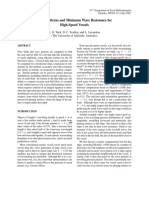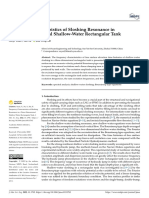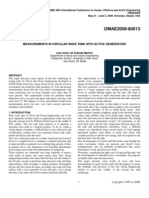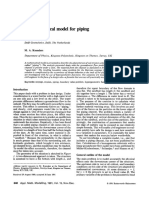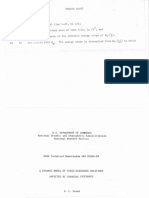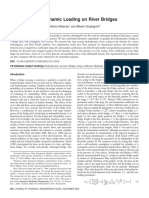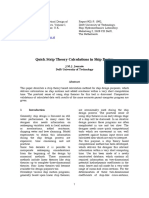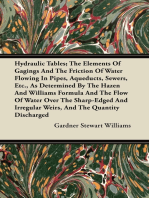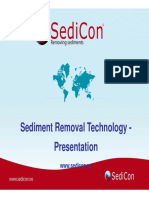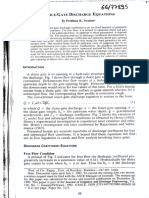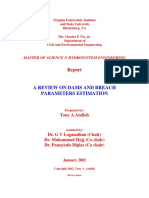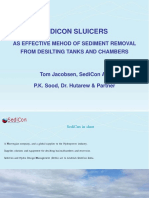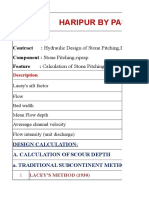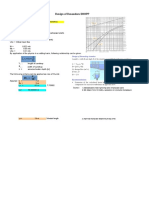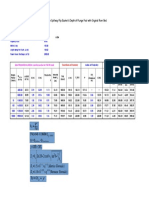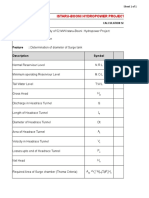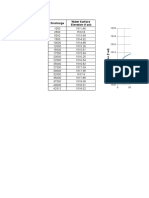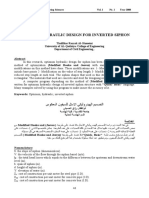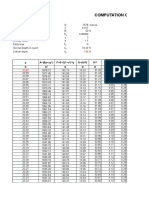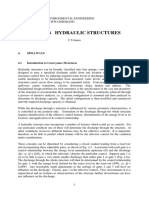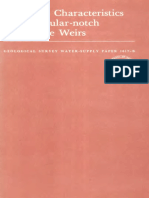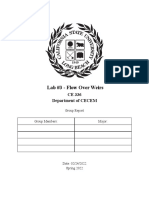Professional Documents
Culture Documents
Computing The Trajectory of Free Jets: Technical Notes
Computing The Trajectory of Free Jets: Technical Notes
Uploaded by
guildkeyOriginal Title
Copyright
Available Formats
Share this document
Did you find this document useful?
Is this content inappropriate?
Report this DocumentCopyright:
Available Formats
Computing The Trajectory of Free Jets: Technical Notes
Computing The Trajectory of Free Jets: Technical Notes
Uploaded by
guildkeyCopyright:
Available Formats
TECHNICAL NOTES
Computing the Trajectory of Free Jets
Tony L. Wahl, P.E., M.ASCE1; Kathleen H. Frizell2; and Elisabeth A. Cohen, P.E., M.ASCE3
Abstract: In recent years, design floods have increased beyond spillway capacity at numerous large dams. When additional spillway
capacity is difficult or expensive to develop, designers may consider allowing the overtopping of a dam during extreme events. For
concrete arch dams, this often raises issues of potential erosion and scour downstream from the dam, where the free jet initiating at the
dam crest impacts the abutments and the downstream river channel. A recent review has shown that a commonly cited equation for
predicting the trajectory of free jets is flawed, producing jet trajectories that are much too flat in this application. This could lead analysts
to underestimate the amount of scour that could occur near a dam foundation, or conversely to overestimate the extent of scour protection
required. This technical note presents the correct and incorrect jet trajectory equations, quantifies the errors associated with the flawed
equation, and summarizes practical information needed to model the trajectory of free jets overtopping dam crests.
DOI: 10.1061/共ASCE兲0733-9429共2008兲134:2共256兲
CE Database subject headings: Jets; Wave overtopping; Scour; Computation; Open channel flow.
Introduction equations conducted by the Bureau of Reclamation has shown
that a widely cited equation is flawed and produces jet trajectories
In recent years, the increasing magnitude of design floods has that are much too flat for this application.
prompted reevaluations of spillway capacity and operational sce-
narios for large dams throughout the world. Many of these inves-
tigations have shown that current spillway capacity is inadequate, Jet Trajectory Equations
raising the possibility that dams might be overtopped during ex-
treme events. Creating additional spillway capacity is often ex- Fig. 1共a兲 shows the flow situation. The reservoir is surcharged to
produce an overtopping head Hovtop. A jet with velocity v0 is
pensive and sometimes technically infeasible, and in these cases,
produced and springs free from the dam crest. If we define the
dam owners sometimes consider accepting overtopping as a
downstream edge of the crest as the origin of an x-y coordinate
planned operation during extreme events. This creates new load-
system, the equation of motion in a plane is
ing scenarios for the dam and raises questions about erosion and
scour downstream from the dam. For concrete arch dams, scour gx2
may occur along the abutments and in the downstream river chan- y = x tan 0 − 共1兲
2v20 cos2 0
nel, where the jet overtopping the dam impacts upon materials
that provide the foundation for the dam. To evaluate the need for where x and y⫽coordinates of the bottom edge of the jet,
protection of these areas, a comparison of the potential hydraulic 0⫽initial angle of the jet from horizontal 共zero in the figure,
attack and erosion resistance of these materials is needed 共Annan- positive if the jet issues upward, and negative if the jet is initially
dale 2006兲. The first stage of this analysis is to define the jet
trajectory and impact zones. A recent review of jet trajectory
1
Hydraulic Engineer, U.S. Dept. of the Interior, Hydraulic Investiga-
tions and Laboratory Services Group, Bureau of Reclamation, Denver,
CO. E-mail: twahl@do.usbr.gov
2
Hydraulic Engineer, U.S. Dept. of the Interior, Hydraulic Investiga-
tions and Laboratory Services Group, Bureau of Reclamation, Denver,
CO. E-mail: kfrizell@do.usbr.gov
3
Civil Engineer, U.S. Dept. of the Interior, Waterways and Concrete
Dams Group, Bureau of Reclamation, Denver, CO. E-mail:
bcohen@do.usbr.gov
Note. Discussion open until July 1, 2008. Separate discussions must
be submitted for individual papers. To extend the closing date by one
month, a written request must be filed with the ASCE Managing Editor.
The manuscript for this technical note was submitted for review and
possible publication on May 5, 2006; approved on April 30, 2007. This
technical note is part of the Journal of Hydraulic Engineering, Vol. 134,
Fig. 1. Free jets 共a兲 overtopping a dam; 共b兲 issuing from an orifice
No. 2, February 1, 2008. ©ASCE, ISSN 0733-9429/2008/2-256–260/
$25.00. through a dam
256 / JOURNAL OF HYDRAULIC ENGINEERING © ASCE / FEBRUARY 2008
inclined downward兲, v0⫽velocity of the jet as it leaves the dam 385, 387兲 for use in designing open-channel spillway chutes and
crest, and g⫽acceleration due to gravity. When the jet issues hori- deflector buckets
zontally, the equation is greatly simplified, becoming
x2
gx2 y = x tan 0 − 共8兲
y=− 2 共2兲 4K共d + hv兲cos2 0
2v0
The derivation of these elementary equations is presented in where d⫽depth of flow, and hv⫽velocity head, as defined previ-
many physics texts 共Halliday and Resnick 1981兲, and these equa- ously. This equation is described as the trajectory of a free jet.
tions in a slightly modified form are given also by Chow 共1959兲. The equation is modified with the factor K, a constant suggested
They describe the motion of a projectile unaffected by wind re- to have values less than or equal to 1.0 共0.9 and 0.75 are com-
sistance. In reality, projectiles or free jets will always travel an x monly suggested兲 when computing a real jet trajectory. When
distance somewhat shorter than that computed by these equations, designing a spillway chute profile, a value of K = 1.5 is suggested
due to wind resistance and jet breakup. to ensure that the floor of the spillway will fully support the jet to
Through algebraic manipulation, the trajectory equation can be reduce the possibility of negative pressures and cavitation on the
restated in terms of the velocity head hv = v20 / 共2g兲 spillway surface. Eq. 共8兲 is also cited in Reclamation’s Design of
Gravity Dams 共Bureau of Reclamation 1976兲 and Design of Arch
x2 Dams 共Bureau of Reclamation 1977兲, and in a recent treatise on
y = x tan 0 − 共3兲
4hv cos2 0 the subject of scour prediction 共Annandale 2006, pp. 146–151兲,
where it is suggested for use in computing the trajectory of free
One could also compute the trajectory of the top surface of the jet
jets overtopping dams.
by simply adding the initial jet thickness t0, assuming that the
Eq. 共8兲 may not raise suspicion at first glance, because it ap-
velocity and angle of orientation are the same as for the bottom
pears to be a simple modification of Eq. 共7兲, replacing the total
edge of the jet
head acting on the orifice with the total head of the open channel
x2 flow. In the dam overtopping case, this is approximately equal to
y = t0 + x tan 0 − 共4兲 the overtopping head if losses are neglected. However, comparing
4hv cos2 0
Eqs. 共8兲 and 共3兲, which was developed directly from the projectile
Davis et al. 共1999兲 presented similar equations for computing motion equation, we see that they are not equivalent, even when
the top surface of the nappe at a free overfall. They related the K = 1. Eq. 共3兲 contains only the velocity head in the denominator
initial velocity of the jet to the velocity at a section upstream from of the second term, but Eq. 共8兲 contains an additional depth term,
the brink. Rouse 共1943兲 related the initial jet thickness to the which causes it to compute a flatter trajectory than Eq. 共3兲. Eq. 共8兲
Froude number at an upstream section, and showed that the ver- would be correct if the entire overtopping head were being con-
tical jet thickness is nearly constant as the jet falls. verted to velocity head, but this does not occur because until the
For convenient application to the situation of flow overtopping flow springs free from the crest, a nearly hydrostatic pressure
a dam, practitioners prefer an equation that expresses the jet tra- profile exists in the flow, and part of the energy is in the form of
jectory as a function of the reservoir head. In the case of flow pressure head. As a first approximation, the flow overtopping the
issuing from an orifice, this can be easily obtained. Fig. 1共b兲 dam should be near critical depth and velocity, with the depth
shows this case, in which the initial velocity, neglecting losses in being about two-thirds of overtopping head and the velocity head
the conduit leading to the outlet, is being the remaining one third. Further confusion is created be-
cause most citations of this equation 共including Design of Small
v0 = 冑2gH 共5兲 Dams兲 do not clearly define the terms d and hv in context, leading
where H⫽total head on the centerline of the opening 共assuming some to conclude that the d value used should be the total over-
the velocity in the reservoir to be negligible兲, and the velocity topping head, with hv then added to it. This causes an even flatter
head is trajectory to be computed.
The development of Eq. 共8兲 is not well documented. The equa-
v20 2gH tion and accompanying discussion of its use appeared in the 1st
hv = = =H 共6兲
2g 2g edition of Design of Small Dams 共Bureau of Reclamation 1960兲
and has appeared essentially unchanged to this date in subsequent
All of the potential energy of the reservoir above the orifice cen- editions and in the other publications already mentioned, includ-
terline is converted to velocity head. In reality, the velocities at ing many foreign-language translations. It has always been pre-
the top and bottom of the jet may be slightly different due to the sented without derivation or citation of its origin, and no
difference in head across the height of the orifice, but this detail is occurrence of it has been found in literature prior to that time.
never considered. Inserting H in place of hv in Eq. 共3兲, we obtain One can surmise that Eq. 共8兲 was developed by simple inspection,
x2 starting with Eq. 共7兲 for the trajectory of an inclined jet issuing
y = x tan 0 − 共7兲 from an orifice and replacing the total head term H with the total
4H cos2 0
head of an open channel flow d + hv and adding the K coefficient
This equation is presented in the Bureau of Reclamation’s Design to account for other factors, such as jet breakup and wind resis-
of Small Dams 共3rd Ed., p. 376兲 共Bureau of Reclamation 1987兲 to tance. Unfortunately, since a rigorous derivation process was not
compute the trajectory of flow issuing through an orifice 共or be- followed, the fact was missed that the velocity head was the cru-
neath a gate兲 at an angle 0. 共It should be noted that a different cial quantity, not the total head. None of the publications present-
sign convention is used in Design of Small Dams, but the equa- ing this equation make a specific argument for the inclusion of the
tion is otherwise the same.兲 depth term. One other Bureau of Reclamation publication ad-
Returning to the case of flow overtopping a dam, a similar jet dresses this topic. Engineering Monograph No. 25—Hydraulic
trajectory equation is presented in Design of Small Dams 共pp. Design of Stilling Basins and Energy Dissipators 共Peterka 1958兲
JOURNAL OF HYDRAULIC ENGINEERING © ASCE / FEBRUARY 2008 / 257
Fig. 2. Jet trajectory error as a function of the Froude number Fig. 3. Ratio of brink depth to critical depth for sloped 共Delleur et al.
1956兲 and horizontal 共Rouse 1936兲 free overfalls
presents equations for computing the throw distance of tunnel
spillway flip buckets. The equations are based on the velocity at depth at the brink of a free overfall is y b = 0.715y c, and this result
the bucket entrance and are thus correct. Eq. 共8兲 does not appear has since been confirmed with only slight variation by many in-
in the monograph. vestigators. Henderson 共1966兲 presents an excellent summary of
the early work in this area, including results from Delleur et al.
共1956兲 for the case of an overfall that is sloped 共Fig. 3兲. More
Trajectory Calculation Errors recently, Rajaratnam et al. 共1976兲 examined the effects of rough-
ness on the brink depth and Davis et al. 共1998兲 explored the
The error introduced into a trajectory calculation by using Eq. 共8兲 combined effects of roughness and slope. One should take note
rather than Eq. 共3兲 depends upon the initial Froude number of the that much of the work on free overfalls is targeted at the use of
jet. Wahl 共2001兲 showed that the fraction of the specific energy free overfalls for discharge measurement in canals and assumes a
associated with the flow depth is 2 / 共2 + F2兲, where F⫽Froude long crest 共i.e., a canal兲 leading up to the overfall; when the crest
number 关F = vo / 共gD兲0.5兴, with D being the hydraulic depth. Simi- is narrower than about 3Hovtop, the situation tends toward the case
larly, the fraction of the specific energy associated with the veloc- of a sharp-crested weir, and the brink depth will begin to ap-
ity head is F2 / 共2 + F2兲. This information can be used in this case proach the critical depth.
to show that the ratio of the erroneous d + hv to the correct hv is In practice, to determine the brink depth and velocity, we
共2 + F2兲 / F2. The range of the jet at any point on the trajectory x is would compute the discharge Q using a weir equation Q
proportional to the square root of the head term in the denomina- = CLH1.5 where C⫽discharge coefficient of the crest, L⫽crest
tor of the trajectory equation, so the ratio of the range computed length, and H⫽overtopping head. We could then compute the
by Eq. 共8兲 and that computed by Eq. 共3兲 is proportional to 共2 corresponding critical depth for that discharge y c = 共q2 / g兲1/3 where
+ F2兲0.5 / F and the percentage error in range prediction is 关共2 q⫽discharge per unit of crest length. The brink depth could then
+ F2兲0.5 / F − 1兴 ⫻ 共100% 兲. Fig. 2 shows the variation of these ra- be determined using the relationships given by Rouse 共1936兲 or
tios and the range prediction error. Delleur et al. 共1956兲, and the brink velocity can be determined
The errors shown in Fig. 2 are dramatic for low Froude num- from the continuity equation. It should be noted that because criti-
bers and still significant for Froude numbers as high as 10. Given cal flow produces the minimum specific energy for a given dis-
the context within which Eq. 共8兲 is presented in Design of Small charge, if one were to compute the specific energy at the brink,
Dams, it was probably developed initially from analysis of flows where flow is supercritical, it will be greater than the specific
having large Froude numbers, where the error is relatively small. energy at the critical section. This seems contradictory, but be-
It would have been difficult to detect the small error in experi- cause the pressure distribution at the brink is no longer hydro-
mental results because of the greater effects of aeration, jet static, the specific energy at the brink is no longer the simple sum
spread, and air resistance, and the difficulty of precisely measur- of y b + v2b / 共2g兲.
ing the trajectory of a jet during an experiment. The factor K was Let us now perform a general analysis of the flow regime
used to account for these effects and also unknowingly adjusted overtopping a dam with a horizontal crest and evaluate the errors
for the error caused by the erroneous equation. The use of K caused by using the incorrect trajectory equation. We will assume
values as low as 0.75 may have arisen from an attempt to obtain no losses, so that the critical depth is two-thirds of the overtop-
agreement with measured trajectories of flows with lower Froude ping depth y c = 共2 / 3兲Hovtop. The critical velocity head is thus the
numbers. remaining 共1 / 3兲Hovtop and the critical velocity is vc
= 共2gHovtop / 3兲0.5. The discharge is Q = y cvcL. If the flow over this
dam were being computed with a traditional weir equation Q
Modeling Jets Overtopping Dam Crests = CLH3/2, the discharge coefficient would be C = 共2 / 3兲1.5共g兲0.5.
Applying Rouse’s relation for the brink depth yields
Considering the jet arising from overtopping of a dam with a
y b = 0.715y c = 0.715共2/3兲Hovtop = 0.477Hovtop 共9兲
horizontal crest, the flow should pass through critical depth on the
crest and spring free from the crest as a slightly supercritical flow. The continuity equation at the critical section and the brink re-
Rouse 共1936兲 concluded from experimental work that the flow quires vcy c = vby b, so the brink velocity is vb = 共1 / 0.715兲vc
258 / JOURNAL OF HYDRAULIC ENGINEERING © ASCE / FEBRUARY 2008
Eq. 共8兲 can be brought into reasonable agreement with Eq. 共3兲
by utilizing a K factor significantly less than 1.0. A value of 0.75
has been suggested by Annandale 共2006兲, but a value of K
= 0.652 produces the best agreement, since we found earlier that
the velocity head at the brink is 0.652Hovtop for a horizontal crest
assuming no losses. The established practice of designing spill-
way chute profiles using Eq. 共8兲 with K = 1.5 is still acceptable,
since the large K value ensures that the jet is fully supported.
However, for correctness, the 共d + hv兲 term in Eq. 共8兲 should be
replaced with just hv. In spillway applications where the Froude
number is large, the effect of this change is minor.
Fig. 4. Comparison of computed jet trajectories and ogee crest Conclusions
profile representing experimental data
The computation of the trajectory for a free jet should always
utilize either the initial velocity of the jet itself 关Eq. 共1兲兴, or the
= 1.399vc. The brink velocity expressed in terms of the overtop- initial velocity head hv = v20 / 共2g兲 of the flow as it springs free into
ping head is the atmosphere 关Eqs. 共3兲 and 共11兲兴. For jets overtopping dams, the
initial velocity can be estimated with reasonable accuracy using
vb = 1.399vc = 1.399共2gHovtop/3兲0.5 = 0.808共2gHovtop兲0.5 relationships first offered by Rouse 共1936兲 for determining the
brink depth of the flow.
共10兲 The flawed Eq. 共8兲 presented in several Bureau of Reclamation
The velocity head at the brink is thus v2b / 共2g兲 = 0.652Hovtop,and manuals and other literature should not be used to model a free
the Froude number at the brink is F = vb / 共gy b兲0.5 = 1.65. From
Fig. jet. It predicts a flatter trajectory than is theoretically possible,
2, the resulting overprediction of the range of the jet with Eq. 共8兲 which may lead analysts to underestimate the potential for scour
is about 32%. For comparison, if the depth at the brink were near hydraulic structures or overestimate the extent of scour pro-
exactly critical depth 共F = 1兲, then Fig. 2 shows that Eq. 共8兲 would tection required. The distance traveled by the jet is overpredicted
overestimate the range of the jet trajectory by about 70%. One with Eq. 共8兲 by 10% to 70% when the initial Froude number of
other consideration is the effect of streamline curvature at the the jet is between 4 and 1, respectively, as is the case for most
brink. In truth, only the bottom streamline of the jet actually flows overtopping dam crests. In practice, Eq. 共8兲 has traditionally
parallels the crest; the middepth streamline is deflected about been adjusted with a K factor varying from 0.75 to 1.0. This has
7 deg downward at the brink 关see Henderson 共1966兲兴, further helped to reduce the errors, but the physical basis for different
shortening the real trajectory, but only by a small amount, as values of K has never been established. In reality, when the cor-
shown in the next section. rect trajectory equations are used, the value of K should be nearly
1.0 共i.e., K should not be included兲 for analysis of flows overtop-
ping dams. For modeling high velocity jets that might be subject
to greater aeration and wind drag, modification of Eq. 共3兲 with a
Comparing Trajectory Equations
K factor such as that included in Eq. 共8兲 may be appropriate, but
To demonstrate the differences between the correct and incorrect further research is needed to determine appropriate values for K.
trajectory equations in a real-world case, trajectories were com-
puted with Eqs. 共3兲 and 共8兲 for an example dam being analyzed
recently by the Bureau of Reclamation. In addition, an ogee crest Notation
spillway profile was computed for the same overtopping head.
The ogee crest shape closely matches a real nappe profile; equa- The following symbols are used in this technical note:
tions describing the shape are based upon large bodies of experi- C ⫽ discharge coefficient;
mental data compiled by the Bureau of Reclamation Design of D ⫽ hydraulic depth, equal to flow area divided by
Small Dams, pp. 365–367 共Bureau of Reclamation 1987兲 and U.S. top width;
Army Corps of Engineers 共Hydraulic Design Criteria, Sheets d ⫽ flow depth;
111-1 to 111-2/1兲 共U.S. Army Corps of Engineers 1987兲. Fig. 4 F ⫽ Froude number;
shows the ogee crest shape compared to the trajectories computed g ⫽ gravitational acceleration;
with Eqs. 共3兲 and 共8兲 for an overtopping head of 4.54 m. The H ⫽ total head;
Froude number at the brink is 1.65, as in the previous general Hovtop ⫽ overtopping head;
analysis. As expected, the ogee crest profile closely matches Eq. hv ⫽ velocity head;
共3兲, while the trajectory computed by Eq. 共8兲 is much flatter. K ⫽ coefficient in jet trajectory equation;
Including an approximate 7 deg downward deflection of the flow L ⫽ weir crest length;
at the brink has only a small effect on the computed trajectories. Q ⫽ discharge;
Eq. 共3兲 also produces results identical to a dimensionless equation q ⫽ discharge per unit crest length;
provided by the U.S. Army Corps of Engineers 共1964兲 for com- v0 ⫽ initial jet velocity;
puting flip bucket throw distances vb ⫽ velocity at brink of free overfall;
vc ⫽ critical velocity;
x
hv
= sin 20 + 2 cos 0 冑
sin2 0 +
y
hv
共11兲
x ⫽ horizontal position of jet trajectory;
y ⫽ vertical position of jet trajectory;
JOURNAL OF HYDRAULIC ENGINEERING © ASCE / FEBRUARY 2008 / 259
y b ⫽ flow depth at brink of free overfall; jectory of free overfall nappe.” J. Hydraul. Eng., 125共1兲, 79–82.
y c ⫽ critical depth; and Delleur, J. W., Dooge, J. C. I., and Gent, K. W. 共1956兲. “Influence of
0 ⫽ initial angle of inclination of jet. slope and roughness on the free overfall.” Proc. American Society of
Civil Engineers, Vol. 82, No. HY4 Paper No. 1038, 1038-30–1038-35.
Halliday, D., and Resnick, R. 共1981兲. Fundamentals of physics, 2nd Ed.,
References Wiley, New York, 44–46.
Henderson, F. M. 共1966兲. Open channel flow, MacMillan, New York,
191–197.
Annandale, G. W. 共2006兲. Scour technology: Mechanics and engineering Peterka, A. J. 共1958兲. Hydraulic design of stilling basins and energy
practice, McGraw-Hill, New York, 146–151. dissipators, Engineering Monograph No. 25, U.S. Dept. of the Inte-
Bureau of Reclamation. 共1960兲. Design of small dams, 1st Ed., United rior, Bureau of Reclamation, Denver, 201–203.
States Department of the Interior, United States Government Printing Rajaratnam, N., Muralidhar, D., and Beltaos, S. 共1976兲. “Roughness ef-
Office, Denver, 282–291. fects on rectangular free overfall.” J. Hydr. Div., 102共HY5兲, 599–614.
Bureau of Reclamation. 共1976兲. Design of gravity dams, United States Rouse, H. 共1936兲. “Discharge characteristics of the free overfall.” Civ.
Department of the Interior, United States Government Printing Office, Eng. (N.Y.), 6, 257.
Denver, 198–199. Rouse, H. 共1943兲. “Discussion of energy loss at the base of a free over-
Bureau of Reclamation. 共1977兲. Design of arch dams, United States De- fall.” Trans. Am. Soc. Civ. Eng., 108, 1383–1387.
partment of the Interior, United States Government Printing Office, U.S. Army Corps of Engineers. 共1964兲. “High overflow dams, energy
Denver, 312–313. dissipators, flip bucket throw distance.” Hydraulic design criteria,
Bureau of Reclamation. 共1987兲. Design of small dams, 3rd Ed., United sheet 112-8, Coastal and Hydraulics Laboratory, Engineer Research
States Department of the Interior, United States Government Printing and Development Center, Waterways Experiment Station, Vicksburg,
Office, Denver, 365–387. Miss.
Chow, V. T. 共1959兲. Open-channel hydraulics, McGraw-Hill, New York, U.S. Army Corps of Engineers. 共1987兲. “Overflow spillway crest.”
360–361. Hydraulic design criteria, sheets 111-1 to 111-2/1, Coastal and Hy-
Davis, A. C., Ellett, B. G. S., and Jacob, R. P. 共1998兲. “Flow measure- draulics Laboratory, Engineer Research and Development Center, Wa-
ment in sloping channels with rectangular free overfall.” J. Hydraul. terways Experiment Station, Vicksburg, Miss.
Eng., 124共7兲, 760–763. Wahl, T. L. 共2001兲. “Hydraulic performance of Coanda-effect screens.” J.
Davis, A. C., Jacob, R. P., and Ellett, B. G. S. 共1999兲. “Estimating tra- Hydraul. Eng., 127共6兲, 480–488.
260 / JOURNAL OF HYDRAULIC ENGINEERING © ASCE / FEBRUARY 2008
You might also like
- Ogee Spillway DesignDocument25 pagesOgee Spillway DesignEr Harsh Mahajan88% (32)
- Offshore Mechanics: Structural and Fluid Dynamics for Recent ApplicationsFrom EverandOffshore Mechanics: Structural and Fluid Dynamics for Recent ApplicationsNo ratings yet
- Helfinstine & Shupe (1972) - Lift and Drag On A Model Offshore PipelineDocument10 pagesHelfinstine & Shupe (1972) - Lift and Drag On A Model Offshore PipelineRodrigo Campos-CabaNo ratings yet
- Seepage PDFDocument25 pagesSeepage PDFChan NovNo ratings yet
- Problems SpillwayDocument7 pagesProblems SpillwayPhacku MiaNo ratings yet
- JFJHFJHFJDocument5 pagesJFJHFJHFJlcbmendesengenhariaNo ratings yet
- Asce Plunge Pool-Puertas Et AlDocument4 pagesAsce Plunge Pool-Puertas Et AlKarina GuadalupeNo ratings yet
- Tuck RevisedDocument16 pagesTuck RevisedSaiSudhakar MamidipakaNo ratings yet
- ASAT - Volume 9 - Issue ASAT Conference, 8-10 May 2001 - Pages 1-24Document24 pagesASAT - Volume 9 - Issue ASAT Conference, 8-10 May 2001 - Pages 1-24shamoonjamshedNo ratings yet
- Discharge Formulas of Crump-De Gruyter Gate-Weir For Computer SimulationDocument8 pagesDischarge Formulas of Crump-De Gruyter Gate-Weir For Computer SimulationEngr Ishfaque TunioNo ratings yet
- 2023 - Mir Et Al Sloshing Loads - NTDocument11 pages2023 - Mir Et Al Sloshing Loads - NTAkhilesh Kumar SinghNo ratings yet
- Otc-6333 - Dedicated Finite Element Model For Analyzing Upheaval Buckling Response of Submarine PipelinesDocument10 pagesOtc-6333 - Dedicated Finite Element Model For Analyzing Upheaval Buckling Response of Submarine PipelinesAdebanjo TomisinNo ratings yet
- Dynamic Analysis of An Inflatable Dam Subjected ToDocument14 pagesDynamic Analysis of An Inflatable Dam Subjected Toahmadalbywr1234No ratings yet
- Fluid Tank & Ship MotionDocument30 pagesFluid Tank & Ship Motionsalman GtrNo ratings yet
- Fluid Tank & Ship MotionDocument30 pagesFluid Tank & Ship Motionsalman GtrNo ratings yet
- Calibration of Submerged Radial Gates: A. J. Clemmens, M.ASCE T. S. Strelkoff, M.ASCE and J. A. Replogle, F.ASCEDocument9 pagesCalibration of Submerged Radial Gates: A. J. Clemmens, M.ASCE T. S. Strelkoff, M.ASCE and J. A. Replogle, F.ASCEBenjamín LagosNo ratings yet
- Investigation of Airship Aeroelasticity Using Fluid-Structure Interaction PDFDocument8 pagesInvestigation of Airship Aeroelasticity Using Fluid-Structure Interaction PDFVictor LiNo ratings yet
- Jmse 10 01792 v2Document13 pagesJmse 10 01792 v2ThiyagarajanNo ratings yet
- Kfvs Adv 2003Document13 pagesKfvs Adv 2003Badreddine EssaidiNo ratings yet
- OMAE2009-80013: Measurements in Circular Wave Tank With Active GeneratorsDocument9 pagesOMAE2009-80013: Measurements in Circular Wave Tank With Active GeneratorsnemzinhoNo ratings yet
- Determinación Campo D KDocument4 pagesDeterminación Campo D KJose Antonio MendezNo ratings yet
- 6) Spillway PDFDocument44 pages6) Spillway PDFHiba N. HadadinNo ratings yet
- Culvert Hydraulics: Comparison of Current Computer Models and Recommended ImprovementsDocument7 pagesCulvert Hydraulics: Comparison of Current Computer Models and Recommended ImprovementsAndres AguirreNo ratings yet
- Refined Energy Correction For Calibration of Submerged Radial GatesDocument10 pagesRefined Energy Correction For Calibration of Submerged Radial GatestuliolimaNo ratings yet
- Bernoulli Theorem and Minimum Specific Energy PDFDocument6 pagesBernoulli Theorem and Minimum Specific Energy PDFNabilahNo ratings yet
- 1 s2.0 S0307904X09810111 MainDocument6 pages1 s2.0 S0307904X09810111 MainMohammed DKHISSINo ratings yet
- Fred - TM16Document55 pagesFred - TM16Anonymous 1n5HpBjNo ratings yet
- Hydrodynamic Loading On River Bridges: Stefano Malavasi and Alberto GuadagniniDocument8 pagesHydrodynamic Loading On River Bridges: Stefano Malavasi and Alberto GuadagniniBoraNo ratings yet
- Numerical Calculation of Ship Wave Resistance Based On Linear TheoryDocument4 pagesNumerical Calculation of Ship Wave Resistance Based On Linear TheoryvalynoNo ratings yet
- Quick Strip Theory Calculations in Ship DesignDocument11 pagesQuick Strip Theory Calculations in Ship Designsalman GtrNo ratings yet
- GARRETT, C. - CUMMINS, P. 2005 The Power Potential of Tidal Currents in Channels. Proc. R. Soc - FullDocument10 pagesGARRETT, C. - CUMMINS, P. 2005 The Power Potential of Tidal Currents in Channels. Proc. R. Soc - FullRayhanKhashibAjjahNo ratings yet
- Numerical Simulation of Deterministic Freak Wave Sequences and Wave-Structure InteractionDocument17 pagesNumerical Simulation of Deterministic Freak Wave Sequences and Wave-Structure InteractionputhenkulamNo ratings yet
- Quick Strip TheoryDocument11 pagesQuick Strip TheoryPopoo KyoNo ratings yet
- A223 PDFDocument4 pagesA223 PDFFahim PathanNo ratings yet
- CFD Simulation of Open Channel Flooding Flows and Scouring, Adhikary Et AlDocument8 pagesCFD Simulation of Open Channel Flooding Flows and Scouring, Adhikary Et AlYonghongCaoNo ratings yet
- 30 HuGaragash JEM10Document16 pages30 HuGaragash JEM10axel.tokoNo ratings yet
- Journee PRADS92 - Quick Strip Theory Calculations in Ship DesignDocument11 pagesJournee PRADS92 - Quick Strip Theory Calculations in Ship Designumair abbasNo ratings yet
- Quick Strip Theory Calculations in Ship Design: WWW - Shipmotions.nlDocument11 pagesQuick Strip Theory Calculations in Ship Design: WWW - Shipmotions.nlYoungkook KimNo ratings yet
- Pipeline Buckling Caused by Axial Loads PDFDocument9 pagesPipeline Buckling Caused by Axial Loads PDFWan Ah-LunNo ratings yet
- Mathematical Modelling of Motions and Damaged Stability of Ro-Ro Ships in The Intermediate Stages of FloodingDocument9 pagesMathematical Modelling of Motions and Damaged Stability of Ro-Ro Ships in The Intermediate Stages of FloodingFarid BerrioNo ratings yet
- Omae2022 78131Document9 pagesOmae2022 78131Rohit KumarNo ratings yet
- The Mechanisms of Ground Surface Subsidence Above Compacting Multiphase Reservoirs and Their Analysis by The Finite Element MethodDocument8 pagesThe Mechanisms of Ground Surface Subsidence Above Compacting Multiphase Reservoirs and Their Analysis by The Finite Element MethodchrissbansNo ratings yet
- 2836 PDFDocument22 pages2836 PDFClandestino EurocanoNo ratings yet
- The Influence of Hull Form On The Motions of High Speed Vessels in Head SeasDocument25 pagesThe Influence of Hull Form On The Motions of High Speed Vessels in Head SeassirousNo ratings yet
- COB09-1054 Panel MethodsDocument9 pagesCOB09-1054 Panel MethodsAnonymous K48TgviNo ratings yet
- Spatially Varied Flow in A Side-Channel: November 2005Document11 pagesSpatially Varied Flow in A Side-Channel: November 2005linNo ratings yet
- Trends: Present in Surge Tank DesignDocument34 pagesTrends: Present in Surge Tank DesignashishroshanNo ratings yet
- W C S WigleyDocument20 pagesW C S WigleyAhmed BelalNo ratings yet
- AN UPDATE ON THE DEVELOPMENT OF THE HULL VANE VfixedDocument11 pagesAN UPDATE ON THE DEVELOPMENT OF THE HULL VANE VfixedNafiri M KautsarNo ratings yet
- PB86149507Document22 pagesPB86149507Nishara NavodyaNo ratings yet
- Smart Hull Drag ReductionDocument7 pagesSmart Hull Drag Reductionjasbak11No ratings yet
- VortexIntake4UrbDrain JHEDocument11 pagesVortexIntake4UrbDrain JHERob616No ratings yet
- Calculation of Bottom Clearance Effects On UV HydrodynamicsDocument25 pagesCalculation of Bottom Clearance Effects On UV Hydrodynamicshalcyon304No ratings yet
- Effect of Storage Capacity On Vertical Drains, LiquefactionDocument12 pagesEffect of Storage Capacity On Vertical Drains, LiquefactionMarco Dos Santos NevesNo ratings yet
- M12 - Jurnal Prof Ming 2020Document16 pagesM12 - Jurnal Prof Ming 2020Mark SandyNo ratings yet
- National Advisory Committee For Aeronautics: Technical Memorandum 1256Document58 pagesNational Advisory Committee For Aeronautics: Technical Memorandum 1256Anatoli KrasilnikovNo ratings yet
- Transonic HullsDocument10 pagesTransonic HullsPaolo VelcichNo ratings yet
- The Mechanics of Water-Wheels - A Guide to the Physics at Work in Water-Wheels with a Horizontal AxisFrom EverandThe Mechanics of Water-Wheels - A Guide to the Physics at Work in Water-Wheels with a Horizontal AxisNo ratings yet
- Hydraulic Tables; The Elements Of Gagings And The Friction Of Water Flowing In Pipes, Aqueducts, Sewers, Etc., As Determined By The Hazen And Williams Formula And The Flow Of Water Over The Sharp-Edged And Irregular Weirs, And The Quantity DischargedFrom EverandHydraulic Tables; The Elements Of Gagings And The Friction Of Water Flowing In Pipes, Aqueducts, Sewers, Etc., As Determined By The Hazen And Williams Formula And The Flow Of Water Over The Sharp-Edged And Irregular Weirs, And The Quantity DischargedNo ratings yet
- Intake SubmergenceDocument14 pagesIntake SubmergenceguildkeyNo ratings yet
- Sediment Removal TechnologyDocument20 pagesSediment Removal TechnologyguildkeyNo ratings yet
- Sluice Gate Discharge CalculationsDocument5 pagesSluice Gate Discharge CalculationsguildkeyNo ratings yet
- 190 Book - Dry - Side - Indus - SFDocument151 pages190 Book - Dry - Side - Indus - SFguildkeyNo ratings yet
- Breach Outflow FormualsDocument120 pagesBreach Outflow Formualsguildkey100% (1)
- Flip Bucket Horizontal Throw KawakamiDocument79 pagesFlip Bucket Horizontal Throw KawakamiguildkeyNo ratings yet
- Hdraulic Design and Application of Labyrith spillwaysPAP-0909Document30 pagesHdraulic Design and Application of Labyrith spillwaysPAP-0909guildkeyNo ratings yet
- Tom Jacobsen and PK SoodDocument17 pagesTom Jacobsen and PK SoodguildkeyNo ratings yet
- Design Air VentDocument16 pagesDesign Air VentguildkeyNo ratings yet
- Paper On Design of DesanderDocument11 pagesPaper On Design of DesanderguildkeyNo ratings yet
- Spillway DesignDocument6 pagesSpillway DesignguildkeyNo ratings yet
- Scour Depth & Stone Apron SizingDocument14 pagesScour Depth & Stone Apron SizingguildkeyNo ratings yet
- Scour Depth & Stone Apron SizingDocument18 pagesScour Depth & Stone Apron SizingguildkeyNo ratings yet
- Hydrology & Hydraulic Analysis Using HEC-RAS SoftwareDocument91 pagesHydrology & Hydraulic Analysis Using HEC-RAS SoftwareguildkeyNo ratings yet
- Design of DesandersDocument5 pagesDesign of Desandersguildkey0% (1)
- Hydraulic ParametersDocument1 pageHydraulic ParametersguildkeyNo ratings yet
- Inventory of Flood Bund PunjabDocument26 pagesInventory of Flood Bund PunjabguildkeyNo ratings yet
- Corumana Dam Emergancy Spillway-Design Case 1 - Labyrinth WeirDocument1 pageCorumana Dam Emergancy Spillway-Design Case 1 - Labyrinth WeirguildkeyNo ratings yet
- Channel DesignDocument8 pagesChannel DesignguildkeyNo ratings yet
- Istaru-Booni Hydropower Project (72 MW)Document4 pagesIstaru-Booni Hydropower Project (72 MW)guildkeyNo ratings yet
- River Discharge Rating CurveDocument2 pagesRiver Discharge Rating CurveguildkeyNo ratings yet
- Istaru-Booni Hydropower Project (72 MW) : Calculation Sheet Rev:0 Contract:Feasibilty Study ofDocument3 pagesIstaru-Booni Hydropower Project (72 MW) : Calculation Sheet Rev:0 Contract:Feasibilty Study ofguildkeyNo ratings yet
- Spillway RatingDocument22 pagesSpillway Ratingguildkey0% (1)
- Design of Roller BucketDocument5 pagesDesign of Roller BucketguildkeyNo ratings yet
- Syphon PDFDocument14 pagesSyphon PDFguildkeyNo ratings yet
- Direct Step Method (DSM) 11.09.2017 FinalDocument20 pagesDirect Step Method (DSM) 11.09.2017 Finalguildkey100% (1)
- Design and Calibration of A Linear Proportional Weir For Flow Control FacilitiesDocument5 pagesDesign and Calibration of A Linear Proportional Weir For Flow Control FacilitiesBenjamín Andres Lagos BerriosNo ratings yet
- Civn7016 Hydraulic Structures: 4. SpillwaysDocument58 pagesCivn7016 Hydraulic Structures: 4. SpillwaysAlexander MakaringNo ratings yet
- Determination of Capacity of Labyrinth Side Weir by CFDDocument8 pagesDetermination of Capacity of Labyrinth Side Weir by CFDMaría Fernanda PerdomoNo ratings yet
- Coek - Info Pressure and Velocity On An Ogee Spillway Crest OpDocument9 pagesCoek - Info Pressure and Velocity On An Ogee Spillway Crest OpmmirelesNo ratings yet
- LAB REPORT - Discharge Over WeirsDocument9 pagesLAB REPORT - Discharge Over WeirsLuli LolNo ratings yet
- Hydraulics and Fluid Mechanics (Indiabix)Document24 pagesHydraulics and Fluid Mechanics (Indiabix)Jawahir GomezNo ratings yet
- Experimental and Computational Fluid Dynamics (CFD) Analysis of Additively Manufactured WeirsDocument7 pagesExperimental and Computational Fluid Dynamics (CFD) Analysis of Additively Manufactured Weirsanon_789699787No ratings yet
- Design of Other Hydraulic StructuresDocument60 pagesDesign of Other Hydraulic StructuresNigusNo ratings yet
- Peyras Et Al 1992Document11 pagesPeyras Et Al 1992Valter AlbinoNo ratings yet
- Weirs Notch Report PDFDocument62 pagesWeirs Notch Report PDFMaxwell RejilNo ratings yet
- Weirs: Classification of Weirs Definition of TermsDocument4 pagesWeirs: Classification of Weirs Definition of TermsLi ReNo ratings yet
- ASTM D5242-01 - Open-Channel Flow Measurement of Water With Thin-Plate WeirsDocument8 pagesASTM D5242-01 - Open-Channel Flow Measurement of Water With Thin-Plate WeirsMelissa Sammy100% (1)
- Lab #3 - Flow Over WeirsDocument12 pagesLab #3 - Flow Over WeirsDeborah SongNo ratings yet
- Aliviaderos Escalonados en PresasDocument75 pagesAliviaderos Escalonados en PresasLuis Carlos LópezNo ratings yet
- WeirsDocument6 pagesWeirsJessicalba LouNo ratings yet
- Piano Key and Labyrinth Weirs at GermanDocument9 pagesPiano Key and Labyrinth Weirs at GermanJean Carlos D. VidalNo ratings yet
- Weir Intake DesignDocument8 pagesWeir Intake Designgrace2gloryNo ratings yet
- Design of Overflow StructureDocument134 pagesDesign of Overflow StructureEng Gulab waziriNo ratings yet
- Hydraulic Design of Canal RegulatorsDocument15 pagesHydraulic Design of Canal Regulatorsناهض عهد عبد المحسن ناهضNo ratings yet
- Flow Over Notches and WeirsDocument23 pagesFlow Over Notches and WeirsKendra Kaiser50% (2)
- Energy DissipatorsDocument11 pagesEnergy DissipatorsAisyahiraMelanOmarNo ratings yet
- WEIRSDocument4 pagesWEIRSJovy AndoNo ratings yet
- Hydro Chapter 6IIDocument27 pagesHydro Chapter 6IIneway mamushetNo ratings yet
- A Review of Piano Key Weir As A SuperiorDocument12 pagesA Review of Piano Key Weir As A SuperiorshalukaNo ratings yet
- Flow Measurement (Open Channel Flow)Document21 pagesFlow Measurement (Open Channel Flow)Vaishnavi SingreNo ratings yet
- SpillwaysDocument26 pagesSpillwaysogulNo ratings yet
- Experiment 6 Hydraulics LabDocument6 pagesExperiment 6 Hydraulics LabAuzaNo ratings yet
- Civil Engineering Department: Abubakar Tafawa Balewa University P.M.B 0248, Bauchi StateDocument11 pagesCivil Engineering Department: Abubakar Tafawa Balewa University P.M.B 0248, Bauchi StateLaura MathiasNo ratings yet
- 18CV33 - Module 4 NotesDocument46 pages18CV33 - Module 4 NotesMANASA.M.PNo ratings yet







